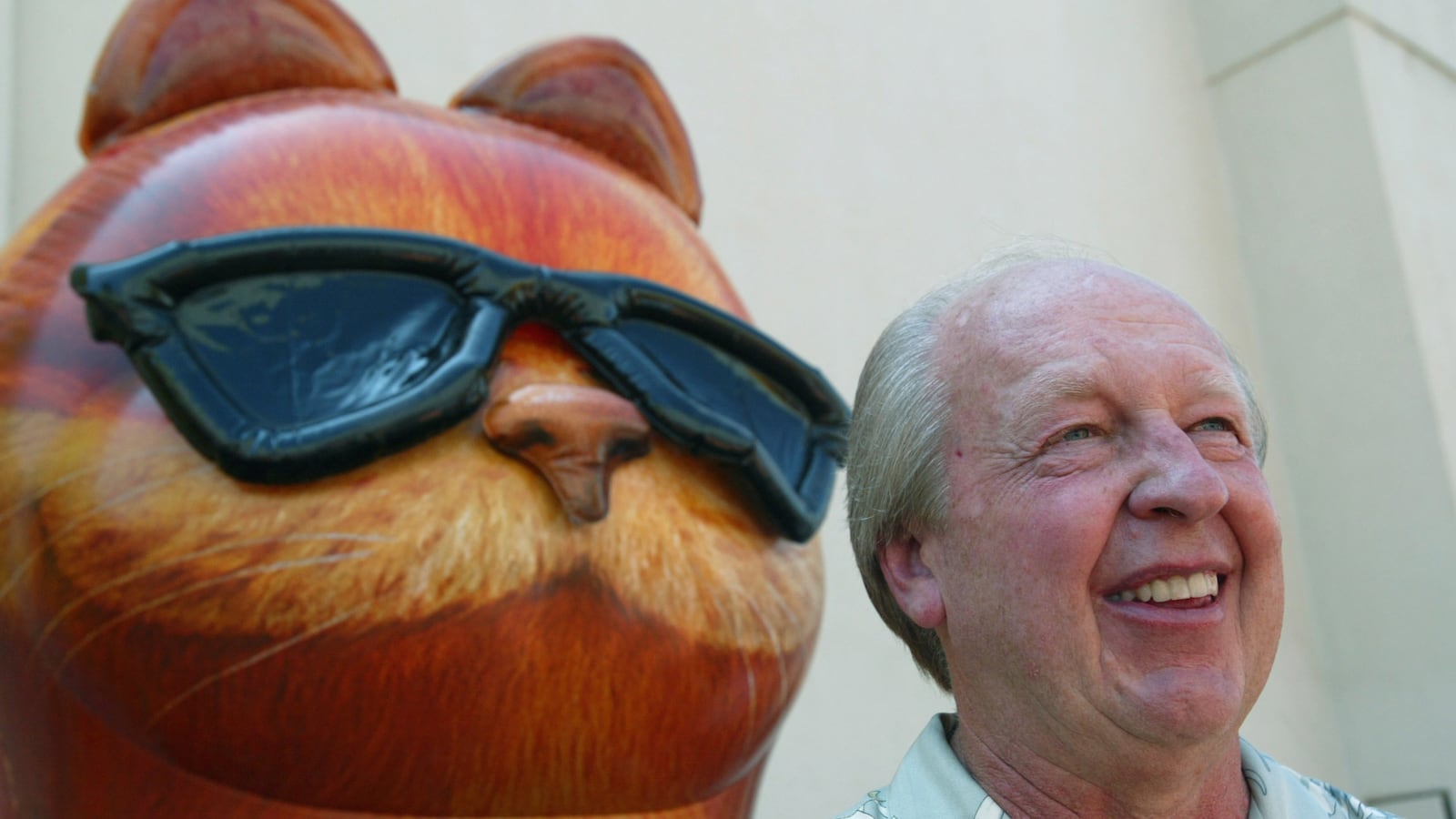Garfield the cat occupies an understated and often overlooked position critical to the history of televised animation.
Introduced as a comic strip by artist Jim Davis in 1978, the lasagna-loving, Monday-hating orange feline appeared in his first animated special in 1982 on the CBS network, Here Comes Garfield. It was directed by Phil Roman, who animated several Dr. Seuss cartoons including How the Grinch Stole Christmas and Horton Hears a Who. The special was developed by Lee Mendelson, the producer responsible for A Charlie Brown Christmas, and José Cuauhtémoc Melendez (a.k.a. Bill Melendez), a legendary animator who did uncredited work on Disney films such as Dumbo, Pinocchio, and Fantasia, and later became the lead artist on the Peanuts specials, as well as the voice of Snoopy and Woodstock.
“You have to bear in mind that when we did the animation for these specials it was a very different time. Everything was done on film,” Davis says. “They were done as movies are done. It was all done in California at the time. They were still working on moviolas and working one frame at a time. We were snipping the actual audio tape.”
Among the roster of animators for that first Garfield special is Utit Choomuang, the overseas animation director on The Simpsons for almost thirteen years, Larry Leichliter, currently a director for Cartoon Network’s Adventure Time, and Eve Fletcher, an ink and paint artist who started her film career on the Ralph Bakshi’s Heavy Traffic and ended it with work on The Little Mermaid and FernGully: The Last Rainforest.
“One thing I really worked with, and everybody bought into, was slowing the action down in place of story,” Davis says. “For a good half hour, I really like to make people feel like it was worth the time, so I like to make them laugh, make them cry, make them think.”
But as Garfield on television gained in popularity, the Peanuts connection became a source of friction. After one more Mendelson and Melendez half hour, Garfield on the Town, Roman created his own animation company to handle the workload of additional specials. That company was Film Roman, and it produced every subsequent Garfield animation, including the Saturday morning cartoon series Garfield and Friends.
With music by R&B great Lou Rawls, the early Garfield cartoons have a distinctive voice, the echoes of which can be heard in today’s animated shows, and yet are unmatched for their high style and soulful tone. Together with Desirée Goyette (who was married to producer Lee Mendelson), Rawls wrote and composed many of the songs included in the specials while also providing the cartoon cat’s singing voice. Goyette continued work on the animation as actor and composer, later becoming the voice of Garfield’s nemesis, Nermal.
“About 1980, I was visiting with Lee Mendelson. We wanted someone to do the opening music,” Davis says. Mendelson asked Davis who he heard for a cat. “Then I remembered when I was in college, there was this jazz singer from the South Side of Chicago we were really into, Lou Rawls. It turned out Lou dropped out of the scene for a while and hadn’t been doing anything for at least a couple years. We were actually the first job Lou had after going through some things. We got to work with him through almost all the rest of the specials. And he can’t read music. He can listen to the music and then do things with it that nobody even envisioned. I think he set the show up.”
Included among the early specials’ cast of characters was former Rhoda doorman, Lorenzo Music, the voice of Garfield until his death in 2001. Thom Huge played Garfield’s human companion, Jon Arbuckle, as well as Binky the Clown, an early incarnation of today’s overenthusiastic, tragi-comic harlequins.
“Binky was a one gag character. It was funny to have a clown who was always screaming,” Davis says. “This was before clowns were scary. I thought it would be funny to have a clown who’s supposed to be happy, but instead is really paranoid. Putting him in surgery, in a library, at a funeral. The only challenge was Thom Huge, who played the voice of Binky, was only good for about two pages of Binky dialogue at a time. After a few minutes, Thom’s voice would go.”
Voicing Odie the dog was Gregg Berger, the original voice of Grimlock on the Transformers cartoons. Also making appearances in the early Garfield specials are the original Bilbo Baggins, Orson Bean, and a pre-Cheers George Wendt.
When asked about what set the specials apart from contemporary fare, Davis says: “Part of it was not letting the editors have the say, but to actually handle it in the voice session. I put all the actors in one room, opened up all of the mics, and then had them read the dialogue. There was no reading of single lines whatsoever because the voices would bleed through on the other mics. So there was no chance of changing the time. We really let the actors get into the parts and play off each other. As a result we got a kind of realism. At times, we’d stop the action and let people follow through the emotion of the moment.”
The first Film Roman Garfield cartoon won a Primetime Emmy for Outstanding Animated Program. “With the primetime specials we had the luxury of the budget and sometimes 8 months,” he says. “We tried to do two specials a year. We worked those hard.”
It was the 1985 Halloween special that set an animated Garfield ahead of its contemporary competitors. Alternately known as Garfield in Disguise and Garfield’s Halloween Adventure, the special follows its titular orange cat through the process of selecting a costume, hitting the town, and eventually hiding from Pirate Ghosts.
The show featured the animation talents of Bob Carlson, part of the Disney team that created the memorable Fantasia segment “Night on Bald Mountain/Ave Maria,” which featured the terrifying demon Malbolge and Bill Littlejohn, who once flew a Luscombe Phantom two-seater over picketing animators as they went on strike outside the mouse’s Burbank studios. It was Littlejohn who drew the iconic image of Snoopy dancing on a piano despite Charles Schulz's protests. Also animating for the special were, Lloyd Vaughan, who worked on many of the post-war Bugs Bunny cartoons and Dave Burgess, who drew the hyena henchmen in The Lion King and the genie in Aladdin.
Davis also pointed out the fantastic quality of longtime TV character actor C. Lindsay Workman, who appeared on series like Bonanza, The Donna Reed Show, and Bewitched. In the special, Workman plays the old man who, as a cabin boy, watched the pirates bury their treasure. “I thought it created an effective, scary scene especially for the young viewers,” Davis says. Perhaps made doubly frightening because not only does the old man frighten Garfield and Odie, but he steals their candy as well.
The Garfield Halloween special repeated its predecessor’s success, winning an Emmy in 1986.
Assisting Lou Rawls and Desirée Goyette with the music was Ed Bogas who lists among his accomplishments composing the music for Frtiz the Cat and the Ossie Davis directed Black Girl. Bogas and Goyette stayed on the Garfield specials and the regular series through the early 90s. They married in 1993 and have been together since.
With so many heavyweights behind the scenes, the special stands out both for its visual style, Lou Rawls distinctive songs, and of course the pirate ghosts. Shooting entirely on film, Davis personally oversaw the animation of the specters at his production studios in Indiana.
“We wanted to create a very special effect for those ghosts to make it very scary,” he says. “In order to make the special effects. They were very difficult to create. In order to get the ghosts to glow, we had to do what was called a double burn. It’s overexposing the picture. We animated them in white on a black background then burned them into the rest of the animation. That gave them that neat glow effect. Probably today you could press the ‘glow’ button on your computer.”
In A Garfield Christmas Special and Garfield’s Thanksgiving, the regular cast is joined by TV and film veteran Pat Carroll, who voiced Ursula in The Little Mermaid and had one of her first roles as a regular performer on The Red Buttons Show. With stories culled from Davis’s childhood, they take place on a farm similar to the one where the cartoonist grew up. Playing Jon Arbuckel’s grandmother, Carroll delivers some of the most emotional moments of the shows. As she remembers her long departed husband, it’s impossible to forget that Davis’s cartoon cat is infused with meaningful parts of his own life. Even the name is derived from James A. Garfield Davis, the cartoonist’s grandfather.
The Garfield specials are also unique for their deadpan delivery and oftentimes bleak worldview. Unlike the oxymoronic “lone wolf,” cats are the ultimate solitary figures and a solitary housecat even more so. Lorenzo Music delivers his lines as the title character in no particular hurry and with plenty of bite. “It’s a really tough,” Davis says. “To handle a line as if you don’t care. Almost in a lazy way. And have it come off with humor. Lorenzo had mastered that casual kind of humor, instead of hammering a line, which by and large comedians were doing in those days.”
When Garfield moved to the big screen in 2004 and 2006, it was fitting for Bill Murray to replace the deceased actor. The role is currently played by voice actor extraordinaire, Frank Welker, who also plays Santa’s Little Helper on The Simpsons and almost every other animal voice in animation.
“Frank got his start as an impressionist,” Davis says. “Many times, out of the booth, I would hear someone else’s voice and it was always Frank standing in the corner, mumbling into the mic, impersonating other actors. He’s a genius. He’s a great talent.”
It was during the run of Garfield and Friends that Film Roman branched out and assumed animation responsibilities on The Simpsons from Klasky-Csupo. Starting with the 1992 episode “Homer the Heretic,” Film Roman has produced every episode since as well as animating The Simpsons Movie. In addition, the studio has produced some of the most famous primetime series of the last thirty years, including The Critic, King of the Hill, and the early seasons of Family Guy.
Although Garfield has been a target of The Simpsons’s acerbity several times over the course of its run (when Binky the Clown knockoff, Krusty the Clown, goes to work at Springfield’s nuclear power plant, he covers his cubicle in the Davis comics to keep himself from laughing) and yet if not for the orange cat, who knows what might have become of Bart Simpson.
To celebrate Garfield's storied past, Anderson Digital has put together the Garfield Holiday Collection, available at Walmart exclusively on November 4th and available on iTunes and digital download on November 11th.





